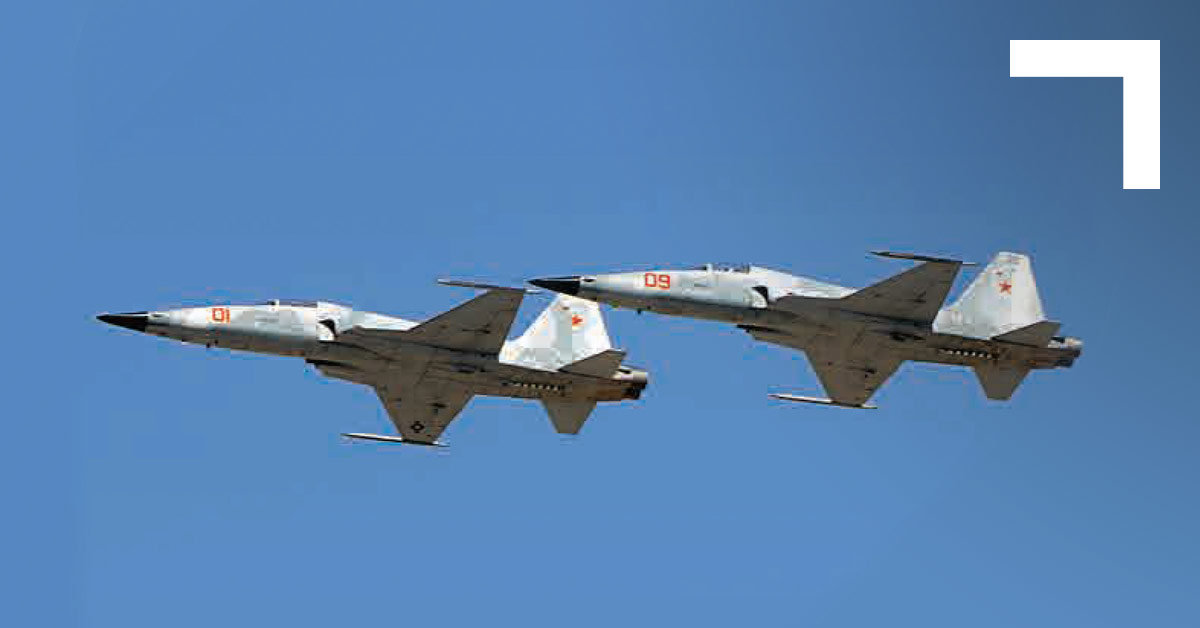In the face of the US and the UK fighter jets and long-range missiles pounding the Houthis’ stronghold is a lone and geriatric F-5 fighter jet.
Thousands Of ‘Forrest Gumps’ To Join US Navy As It Struggles To Attract Recruits; Doors Now Open For High School Dropouts
The Houthi rebels’ strange air force boasts of a single F-5 supersonic fighter jet, which once dominated the skies. The Russians procured one F-5 aircraft from Vietnam to assess its capability against its newly minted MiG-21 interceptor.
The F-5 in the Houthi rebels’ air force was seized from the Yemen government during the civil war. It made an appearance on a flyover during a Houthi parade in Sanaa in 2023.
According to reports, the Houthi aircraft was probably one of 12 that the US had dispatched to Yemen in the late 1970s to discourage the Soviet Union from engaging in combat there.
F-5s are supersonic fighter planes rolled out by the US military in the 1960s and 1970s, which underwent various upgrades.
The Soviet Union was able to acquire an American F-5 fighter plane during the Vietnam War. It was the only time that the Soviets laid their hands on the American fighter jets, whereas the US was able to acquire MiG-21, MiG-25, and MiG-29 to test its mettle.
The 522nd Fighter Squadron of the US Air Force was stationed at the Bien Hoa military facility, where it was mainly taken over by North Vietnamese forces in 1975. Together with other military equipment, one of the most infamous fighter planes of all time was subsequently sent to the Soviet Union as part of military cooperation for purported “evaluation.”
The F-5 was one of the new fighter jets in the defense market and an imposing one. The Soviets decided to assess its newest fighter jet at the moment, the MiG-21. The Soviet engineers wanted to find out how the MiG-21 would perform against the American jet in aerial battles.
Much to their dismay, the F-5 had beaten the MiG-21 in every simulated air-combat engagement.
“Their initial reaction was that the MiG-21 was a superior fighter, especially thanks to its higher thrust-to-weight ratio. They promptly tested the F-5 against the MiG-21 and found that the MiG…. lost every time,” Soviet Air Force test pilot Vladimir Kondaurov wrote in his book “Life-long Runway.”
“At high speeds and energy fighting, the two aircraft were considered to be equals. But as energy bleeds off and speeds get slower, developing into a maneuvering dogfight, the F-5 pulled the advantage and got into a position to kill the MiG-21. This shocked the Soviets, and they determined that the F-5’s superior aerodynamics made up for its lesser power-to-weight ratio and gave it an edge at slower speeds,” Kondaurov concluded.
Talking about the “Foreigner,” the moniker he gave to the F-5 fighter jet, Kondaurov said that the disassembled American F-5E fighter jet was delivered to their air base at Aktubinsk, along with its pilot manual.
The F-5E was the latest variant of the aircraft marked by an increased engine thrust. It was smaller in size than the MiG-21. The F-5 had two engines installed side-by-side in the fuselage, a sharp swept-down nose, and short tapered wings. The Soviet engineers assembled the aircraft and made it fly-worthy.
After understanding the basic specifications of the American jet, the Soviets decided to set up a mock air-to-air combat with MiG-21 Bis. Kondaurov was in his “native” Mig-21, and Soviet team leader Nikolay Stogov was flying the F-5.

“The close air combat started head-on in equal positions. Every flight ended with the same result: MiG-21 lost, although it had a much higher thrust-to-weight ratio. I laid myself out just to keep the initial position. I took the most out of the aircraft and took all he could give, but the targeting angle grew steadily, and in a few minutes, the “bandit” (F-5) was on my tail. Only tactics could save me,” the Soviet test pilot recalled.
“What I was stricken by the most is that the result of the mock fights took not only the generals by surprise (one could explain this somehow) but also the military research departments of the Air Force and even the aviation engineers. They would review the data records a thousand times and ask the pilots, especially me. Frankly, I was somewhat confused as well, but when I tried the F-5, I realized that it was not an ordinary one,” Kondaurov added.
The pilots realized that at high speeds, both aircraft were equal. However, at lower speeds, the F-5s better aerodynamics won the day against Mig-21’s better thrust/weight ratio.
Bamboozled by the results, the Soviets pitted the F-5 against MiG-23. But the results were the same. “The result was the same with the only exception that the agony lasted for 4-5 minutes.” Kondaurov was given a free hand to break any angle of attack limitations.
“In the dogfight, I set the optimal wing sweep manually, but all in vain. The foreigner would slowly but steadily approach my tail,” the test pilot reminisced.
These tests were used to give recommendations to the Ethiopian pilots flying MiG-21 on how to combat the American F-5. Kondaurov said that the recommendations were different from what his team had compiled.
“Our ‘experts’ suggested not to engage in a close dogfight but to use the ‘hit-and-run’ tactics instead. What about the MiG-23, everyone preferred to forget about it,” he said.
The “Foreigner” was then given to the Soviet aviation industry – not for flying but to study its structural features that can be used in future projects. The author suggests that the Su-25 close air support aircraft emerged. It had the wheel brakes on the rudder pedals, “maneuvering” wing configuration, and a different approach to the cockpit layout.
- Ritu Sharma has been a journalist for over a decade, writing on defense, foreign affairs, and nuclear technology.
- She can be reached at ritu.sharma (at) mail.com
- Follow EurAsian Times on Google News




